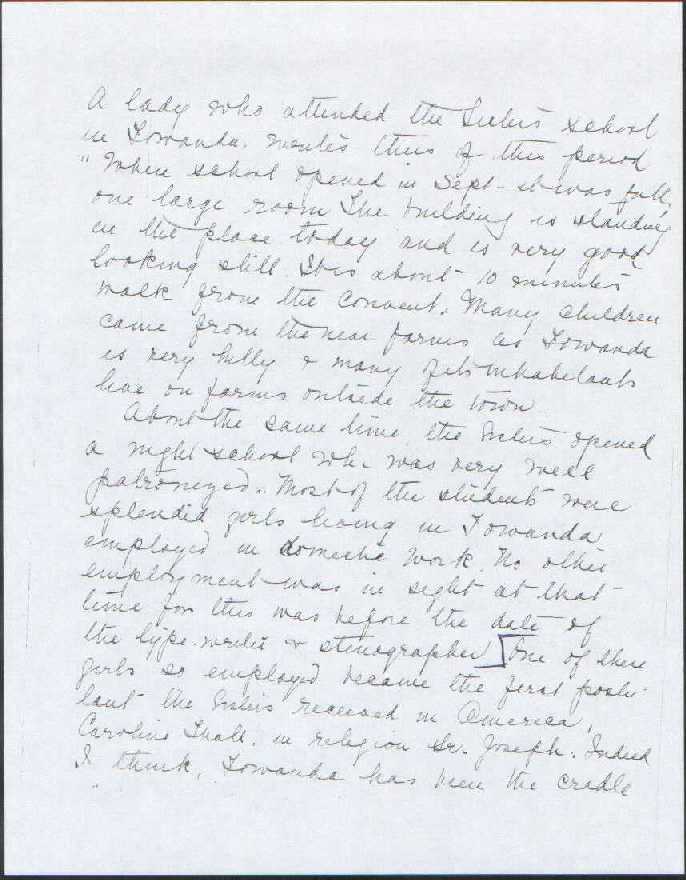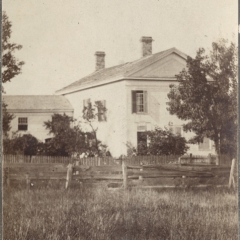
The Story of Sister Joseph
Book of Life
Society of the Holy Child Jesus
Waseca, MN
Most likely written by the secretary of the local Society convent
The Vocation of Sister Joseph
Born Carolyn Thall (1844-1893)
From Materials Submitted by Tom Gerber

Edited by Bob Sweeney
Sullivan County Historian
December 2002
The Vocation of Sister Joseph
The first vocation to the Sisterhood from the Catholic parish in Towanda was Mary Thall. She was the first postulant received by the Sisters of the Holy Child in America. In religion, her name was Sister Joseph and was a Lay Sister. She made her vows in 1864-- and died in 1893. Sister Joseph's sister, Anna Thall, became a Franciscan, Sister Mary Anacleta. She entered the Convent at St. Mary's Hospital, Philadelphia, in 1877--and was professed August 12, 1879. She died in Tacoma, Washington, February 3, 1928.
The following information was contributed to the Sullivan County Genealogical Society by Tom Gerber in May 2002. All the materials are from the Society of the Holy Child Jesus archives. Tom wrote to them hoping to find information on Carolyn's mother, Carolyn Lefevre Thall, namely, where she was born in France. They sent him the materials presented below. The materials include excerpts or notes from the Book of Life. The Book of Life gives basic facts which can >contribute to a story about a person, but is not a story in itself. It is a Province-wide listing and entries are made at the Provincial Office for the American Province. The author of the original handwritten document is unknown.
In May 2013, the Society honored Sister Joseph with a special ceremony at the order house in Waseca. Here is a copy of the actual Celebration Announcement posted on their web page: Sister Joseph Commemoration.
Each convent in the order keeps its own local journals. So, the House Journals and Waseca Annals are from the Society's church school records starting in Waseca, Waseca County, Minnesota, founded in 1886. Here is a historical overview of the Catholic community in Waseca, as given to Tom by the Waseca County Historical Society:
When the village of Waseca was incorported in 1869, several Catholic families in the community met to organize a parish. On 24th October 1869, they met at the home of Thomas White. Mass was celcbrated in the Madson store before the first church was erected in 1874. At the turn of 20th century, the present Catholic church was erected. The parish school started in 1886 under the direction of the Sisters of the Holy Child Jesus. In 1904, the Sisters of St. Francis took over the school. Monsignor James J. Treanor served as paster of the congregation from 1890 until his dealth in 1942.
Let us begin by reference to the original records written in Waseca in 1893:
Sister Joseph became a Sister of the Holy Child Jesus in Towanda PA, was sent to Waseca, Minnesota in 1886, and
seven years later died at the age of 49, after serving 29 years in the sisterhood. She died in 1893.
From the House Journal
January 1893
3rd: School began today with Low Mass - as there is so much sickness in the town.
16th: Reverand Mother Antonia accompanied by Sr. Joseph went to St. Paul, to the hospital where
sister is to be treated.
19th: Sister Joseph died this morning at 2.30 at the hospital in St. Paul. Dismissed the school at
eleven until Monday. Rev. Mother Antonia returned on the 1 1/2 train with Sister's remains, which were placed in
the chapel.
21st: Mass this morning at 7:30 said by Bishop Cotter in the Chapel. Funeral Mass in the church at 9 o'clock.
High Mass sung by Father Treanor. The members of the choir asked as a special privilege to be allowed to sing.
The Bishop gave thc absolution and preached a beautiful sermon taking for his text, "Whether we live or whether
we died, we are the Lord's". The snow was so deep all went in sleighs. Father Treanor went to the cemetery,
and after the usual prayers, knelt and said some prayers for the repose of Sister's soul. R.I.P. Many people
followed to the cemetery*. The Bishop called in the afternoon before leaving (Waseca) and was very kind.
22nd: Sunday - Sr. Joseph was prayed for at all the masses.
According to the Annals, the cemetery referred to is located at Sacred Heart Church.
From the Waseca Annals
Sister Joesph was the first American received as a postulant in the Society of the Hold Child Jesus. She was Caroline
Thall of Towanda where she was born and raised and where she first met the Sisters of the Holy Child. The Thalls were
devout Catholics. Caroline, the second of twelve children was described as a happy, devout child. One who had been a
schoolmate with her assures us that she was much loved by her companions and the immediate family, all of them trying
to dissuade her from the intention she later formed of entering the Convent. They were not rich people, owning only a
small farm, and the expenses incurred by her entering the Convent somewhat alarmed them. However, she held her
own and was received by Mother Mary Xavier (Noble) who gave her the hood. Apparently Caroline lived at the Convent in Towanda as a postulant. The companion referred to above wrote:
The children had good crying spells after she left us. I watched my chance to steal out of the classroom, down to the basement where one of the windows looked on the back of the Convent. Then I sometimes saw her, washing, ironing, or sewing as the case may be. I do not think she was more than 18 when she went to the Convent, and sometimes I ran over and spoke to her. For a while all went well, but one day she told me not to come again as she had a rule of silence to keep and I must not make her break it by talking. I did as she bade me for I would not for worlds have prevented her being received as a Sister.
And so, Sister Joseph, once known as Caroline Thall, cast in her lot with the gallant little group of Holy Child Sisters who gladly endured the hardships of pioneer days and who, through silence, prayer and hard work seasoned with gaiety, strengthened the Kingdom within and channeled grace to those with whom they came in contact.
From the Book of Life
A lady who attended the Sisters school in Towanda writes thus of the period: "when school opened in Sept. it was
full, one large room. The building is standing in the place today and is very good looking still. It was about 10
minutes walk from the convent. Many children came from the near farms as Towanda is very hilly & many of its
inhabitants live on farms outside the town. About the same time, the Sisters opened a night school which was very
well patronized. Most of the students were splendid girls, living in Towanda, employed in domicile work. No other
employment was in sight at that time for this was before the date of the typewriter & stenographer. One of these
girls so employed became the first postulant the Sisters received in America, Caroline Thall, in religion Sr.
Joseph. Indeed I think Towanda has been the cradle of the Society of the Holy Child Jesus in this country.
It gave three splendid religious--Sr. Michael (Dunn), Sister Joseph (Thall) and Sister Hilda (Lynch)--all devoted
nuns, all rocked in the wooden cradle (rocked hard too), nuns who labored and suffered much. Mother Agatha remarked
long years after [that they had] "paid the Society for coming to America". Probably it was at the night school
classes that Caroline Thall first met the Sisters whose community she was so soon to join. Only about [??] whole
school year and then the nuns had to leave Towanda and go to Philadelphia where they have remained ever since.
Mother Sr. John (McMaster) writes of Sister Joseph. as Professed: "A quaint quiet, pious nun.
When I was a girl at Sharon, 1873-1879, she used to brush the children's hair on Saturday mornings and
whilst she did so told us stories in German or recited German poems. In 1884, she went West and I did not
meet her again."
Note: A Professed nun is one who has professed vows in the Society.
"Sharon" refers to the convent at Sharon Hill, PA.
To return to the account given by her friend of this time:
**
On September 9, 2001, Tom Gerber wrote to the Bradford County Genealogical Web page the following comment, which refers to the vocation of another Thall child: "We have been researching our LEFEBVRE and THALL ancestors and recently ran across an entry in a history book that says: This includes two daughters of Caroline Lefebvre Thall. It says: The first vocation to the Sisterhoods from the parish is Miss Mary Thall. She is the first postulant received by the Sister of the Holy Child in America (Towanda). In religion, her name was Sister Mary Joseph. She made her vows in 1864 - Died in 1893. Sister Mary Joseph's sister, Anna Thall, became a Franciscan, Sister Mary Anacleta. She entered the Convent at St. Mary's Hospital, Philadelphia, in 1877 - was professed August 12, 1879. She died in Tacoma, Washington, February 3, 1928."
Copyright © 2002 Robert E. Sweeney and individual Contributors. All Rights Reserved. Prior written permission is required from Robert E. Sweeney and individual Contributors before this material can be printed or otherwise copied, displayed or distributed in any form. This is a FREE genealogy site sponsored through PAGenWeb and can be reached directly at ~Sullivan County Genealogy Project (http://www.rootsweb.com/~pasulliv)